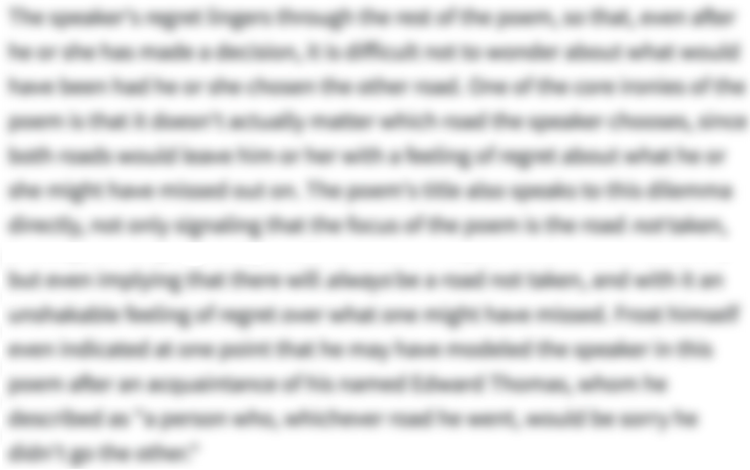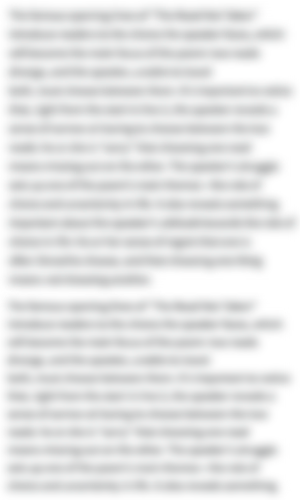The Full Text of “To the Virgins, to Make Much of Time”
1Gather ye rose-buds while ye may,
2Old Time is still a-flying;
3And this same flower that smiles today
4Tomorrow will be dying.
5The glorious lamp of heaven, the sun,
6The higher he’s a-getting,
7The sooner will his race be run,
8And nearer he’s to setting.
9That age is best which is the first,
10When youth and blood are warmer;
11But being spent, the worse, and worst
12Times still succeed the former.
13Then be not coy, but use your time,
14And while ye may, go marry;
15For having lost but once your prime,
16You may forever tarry.
-
“To the Virgins, to Make Much of Time” Introduction
-
"To the Virgins, to Make Much of Time" is Robert Herrick's famous 1648 carpe diem poem, encouraging women (and readers in general) to make the most of their youths while they still can. Taking the posture of a wise counselor, the poem's speaker cautions "coy" women that youth comes to an end, death comes for everyone, and no one's sexual prime lasts forever—so they'd probably better take a lover while they still can! Beyond its cheekiness, this is a poem about enjoying life while it's there to be enjoyed.
-
-
“To the Virgins, to Make Much of Time” Summary
-
Pick rosebuds while you still can. Old Man Time is always rushing, and the same flower that's in bloom today will be dying by tomorrow.
The beautiful light of heaven, the sun, is getting higher and higher. The higher he gets, the sooner he'll be done rising, and the closer he'll be to setting.
The best part of a life is the first part, your hot-blooded youth. But after that's over, life gets progressively worse.
So don't be evasive, but instead use your time well, and while you can, go get married. Because once you've lost the bloom of your youth, you may wait forever for a marriage that never comes.
-
-
“To the Virgins, to Make Much of Time” Themes
-

Seizing the Day
In “To the Virgins, to Make Much of Time,” a speaker encourages young women to seize the day and enjoy their youth—and, more specifically, to have plenty of sex and find a husband while they’re young. Youth, the speaker insists, is the best part of life, and it’s all too easy to waste one’s limited time by being “coy”—especially in matters of sex.
The speaker begins by urging listeners (those "virgins" of the title) to gather a familiar image of both youth and sex: “rose-buds.” Those new buds, emerging in the spring and summer, suggest fresh and blooming youth, and they’re an old symbol of love and of the female body.
Also note that at the time of the poem’s composition, the word “virgins” would have meant young women specifically, rather than just anyone who hasn’t had sex. In encouraging “virgins” to gather their rose-buds, then, the speaker points this poem directly at young women and encourages them to take advantage of their youthful sexuality while they still can.
Those “rose-buds” also seem to represent both sexual experiences and the young women themselves: while they “smile” today, they’ll be “a-dying” tomorrow. Both sex and youth, the image suggests, are limited-time opportunities for women.
The speaker then turns to bigger images that reflect the relentless passing of time, creating a sense of urgency: youth, sexuality, and life itself, the speaker implies, don’t keep forever. The poem follows the sun as it moves through the sky, getting closer and closer to setting every second.
Then, the speaker gets more literal, stating flat out that “[t]hat age is best which is the first, / When youth and blood are warmer.” The image of warm blood seems to link human bodies to the sun, which also comes to a peak of heat and then steadily diminishes. These lines sound downright ominous, and seem intended to scare the “virgins”: the speaker’s visions of time’s remorseless passage suggest that things are only going to get worse for these young women.
Having made this broader point, the speaker returns to directly addressing the “virgins” in the final stanza—and the poem's language here hints that the speaker might have some skin in this game. When the poem urges the young women not to be “coy,” the speaker's suggesting that they be sexually free and easy. The speaker follows this up with encouragement to go “marry”—the socially-approved way of channeling sexuality in the 17th century.
However, leading with a discouragement of coyness seems almost like the opposite of rushing people into marriage. There’s a sly undertone here, even as the speaker seems to keep these recommendations strictly above board.
In the final lines, the speaker takes a frostier tone again, warning the young women that once they’re past the prime of their youths, they might not have the chance to take all the sexual opportunities they’re refusing now. In that back-and-forth between encouragements to enjoy sexuality while it’s freshest and warnings that youth doesn’t last forever, the poem’s speaker thus does something rather sneaky.
While the poem is making perfectly reasonable statements—youth doesn’t last forever, sexuality is fun—it's also slyly doing a little arguing on the speaker's own behalf. After all, it takes two to gather the rosebuds the speaker has in mind!
- See where this theme is active in the poem.
-
-
Line-by-Line Explanation & Analysis of “To the Virgins, to Make Much of Time”
-
Lines 1-2
Gather ye rose-buds while ye may,
Old Time is still a-flying;The title of "To the Virgins, to Make Much of Time" lets the reader know what this poem is about right from the get-go. The speaker here has a clear audience, and a clear point: he's here to tell the young women of the world to use their time well. (Note that, at the time of the poem's writing, "virgins" was almost certainly meant as a reference to young women. For more on how the reader knows that these "virgins" are very likely women, and the speaker very likely a man, take a look at the Themes and Speaker sections of this guide.)
With that title, it's no surprise that the poem begins with a command: "Gather ye rose-buds while ye may." This apostrophe, pointed straight at the "virgins" of the title, lets the reader know that to "Make Much of Time" isn't a matter of, say, learning a new language or reading a good book or volunteering down at the soup kitchen.
The clue is in those "rose-buds." Roses are an ancient symbol of love, sex, and female beauty, and their early appearance here—plus the speaker's specific address to "virgins," women who haven't yet had sex—firmly places this poem in the realm of romance. There's also a general feeling of sensual pleasure here: think of the delicious smell of a new rose, and the warm summer weather that brings the flowers into bloom.
That the speaker encourages young women to gather "rose-buds," plural, also suggests that he's a bit of a libertine. He's suggesting that these ladies gather, not one perfect rose-bud, but whole bouquets of sexual experience.
Why? Because "Old Time is still a-flying." With the familiar personification of time as an old (but speedy) man, the speaker introduces the poem's major idea: life is short, and you've got to have fun while you can.
-
Lines 3-4
And this same flower that smiles today
Tomorrow will be dying.

Unlock all 238 words of this analysis of Lines 3-4 of “To the Virgins, to Make Much of Time,” and get the Line-by-Line Analysis for every poem we cover.
Plus so much more...
Get LitCharts A+ -
Lines 5-8
The glorious lamp of heaven, the sun,
The higher he’s a-getting,
The sooner will his race be run,
And nearer he’s to setting. -
Lines 9-12
That age is best which is the first,
When youth and blood are warmer;
But being spent, the worse, and worst
Times still succeed the former. -
Lines 13-14
Then be not coy, but use your time,
And while ye may, go marry; -
Lines 15-16
For having lost but once your prime,
You may forever tarry.
-
-
“To the Virgins, to Make Much of Time” Symbols
-

Rosebuds
The "rose-buds" of the poem's famous first line tap into an ancient tradition of treating roses as a symbol of love, sex, and womanhood. Here, the rosebuds seem to be images both of sexual experiences (perhaps suggesting kisses with their puckers) and of the "virgins" themselves, whose youth is as gorgeous and as temporary as the blooming flowers.
It's also important that the flowers here aren't full-blown roses, but buds. This image of a flower on the verge of bursting into bloom suggests the potential energy of the women's youth and beauty, but also looks forward to the sad fact that "this same flower that smiles today / Tomorrow will be dying."
- See where this symbol appears in the poem.
-

The Sun
The sun symbolism in "To the Virgins, to Make Much of Time" speaks to both the joyful energy of life and the ceaseless march of time. Human beings have always measured time by the movements of the sun and moon, so the sun has a clear connection to the idea of time's passage—and in this poem, this "glorious lamp" is always on its way toward setting. In other words, time is also moving forward, nearing its end.
But the sun here is still "glorious," a source of warmth, light, and life itself. In this poem's view, then, the beauty of life's metaphorical morning is perhaps only intensified by how quickly it fades into night.
- See where this symbol appears in the poem.
-
-
“To the Virgins, to Make Much of Time” Poetic Devices & Figurative Language
-
Alliteration
"To the Virgins, to Make Much of Time" is a poem about how terribly quickly time passes—a potentially painful topic that the speaker softens with lighthearted, joyful sounds. The alliteration here adds musicality to the poem's warnings, but also helps to emphasize the speaker's more serious point.
For example, take a look at the alliteration in lines 3-4:
And this same flower that smiles today
Tomorrow will be dying.The crisp alliterative /t/ sounds here, like the ticking of a clock, suggest just how quickly "tomorrow" follows on "today." Similarly, the repeated /r/ of "The sooner will his race be run" speeds up the pace of line 7, hurrying the reader along as fast as the sunset the line describes.
Something similar happens in lines 10-11, where the lively "warmer" blood of youth transitions into "the worse, and worst / Times" of later life. Here, the alliterative link between those /w/ sounds makes it clear that there's a thin line indeed between summery warmth and the worst times. (That echo on "worse" and "worst" is also an example of polyptoton—see the Poetic Devices entry on repetition for more on that.)
Another connection between the poem's ominous and cheerful moods comes in the final stanza, when the speaker decides to give some straightforward advice: "while ye may, go marry." That /m/ link between a warning "may" and a celebratory "marry" is right at the heart of the poem's philosophy. There's plenty in life to be enjoyed, the speaker insists—but one's got to snatch one's pleasures while one can!
- See where this poetic device appears in the poem.
-
Apostrophe


Unlock all 253 words of this analysis of Apostrophe in “To the Virgins, to Make Much of Time,” and get the poetic device analyses for every poem we cover.
Plus so much more...
Get LitCharts A+ -
Enjambment
-
Personification
-
Metaphor
-
Repetition
-
Caesura
-
-
“To the Virgins, to Make Much of Time” Vocabulary
Select any word below to get its definition in the context of the poem. The words are listed in the order in which they appear in the poem.
- Ye
- A-flying, a-getting
- Succeed
- Coy
- Prime
- Tarry
Ye-
An old-fashioned word for "you."
- See where this vocabulary word appears in the poem.
-
Form, Meter, & Rhyme Scheme of “To the Virgins, to Make Much of Time”
-
Form
"To the Virgins, to Make Much of Time" encourages its audience to seize the day, and belongs to a genre of carpe diem poems in which the kind of day-seizing being advocated for is pretty specific: these are poems addressed to women on behalf of men who want to sleep with them. Andrew Marvell and John Donne, contemporaries of Herrick, also wrote famous and beautiful examples of the genre.
Where Marvell's and Donne's carpe diem poems are long, lyrical, and philosophical, Herrick keeps things comparatively straightforward and cheerful. "To the Virgins, to Make Much of Time" uses 16 lines broken into four quatrains, each with a simple ABAB rhyme scheme and a jaunty, informal common meter. These choices present even the poem's weightier points about the inevitable decline of youth with a light touch.
-
Meter
"To the Virgins, to Make Much of Time" uses common meter. This is a metrical pattern that turns up everywhere in English-language poetry, from hymns to nursery rhymes, so it has a familiar air—and makes the speaker's advice sound friendly and jaunty. This is an upbeat meter for a witty poem.
Common meter uses alternating lines of iambic tetrameter and iambic trimeter: in other words, lines of four da-DUMs and lines of three da-DUMs. The trimeter lines (all the even-numbered lines in the poem) have feminine endings thanks to an extra dangling unstressed syllable. Look at the third stanza as an example:
That age | is best | which is | the first,
When youth | and blood | are warmer;
But be- | ing spent, | the worse, | and worst
Times still | succeed | the former.These even-numbered lines thus can alternatively be defined as more iambic tetrameter but with catalexis, which just means that their final beat is missing (note how, if there were another stressed beat at the end of each of these lines, they'd become regular iambic tetrameter). Regardless of terminology, the effect is the same: the lines fade out, echoing the fleeting nature of time.
The poem has some substitutions throughout to keep things interesting. The speaker even mixes things up a little in the first line. Take a look at how the stresses work here:
Gather | ye rose- | buds while | ye may
Notice that the first word of the first line, "Gather," is a trochee (DUM-da) rather than an iamb. The third foot is then a spondee (DUM-DUM). This grabs the reader's attention just as the speaker tries to grab the attention of the "virgins" to whom he speaks.
-
Rhyme Scheme
"To the Virgins, to Make Much of Time" uses a simple rhyme scheme, with each stanza running:
ABAB
This easy back-and-forth pattern fits with the poem's simple meter and simple message, making the speaker's advice to young women feel friendly in spite of his more ominous ideas about aging and decline.
In most cases here, the B rhyme in each stanza is specifically a feminine rhyme. It rhymes multiple syllables, the last of which is unstressed—for example, "a-flying" and "dying." This might seem insignificant—except that, traditionally, monosyllabic rhymes are called "masculine" and polysyllabic rhymes are called "feminine." The poem thus sneakily creates a dance between the male and the female in its rhymes.
-
-
“To the Virgins, to Make Much of Time” Speaker
-
The poem's speaker is anonymous. On one level, this helps the poem feel universal in its message; this could be anyone encouraging young women to seize the day.
At the same time, when the reader considers the broader context of the poem, there's a lot they can deduce about the speaker. For instance, the reader can guess that this speaker is probably a "he." This poem belongs to the carpe diem tradition, a genre of poem in which men cajole women into sleeping with them through some combination of flattery and warnings about everyone's inevitable death.
The poem itself doesn't specify a gender for its speaker, and readers don't have to interpret it this way! Still, knowing this context can be helpful in understanding what's happening here.
This speaker's address to "the Virgins" might suggest that he's one man among many to give this scheme a shot. The way the poem is shaped also tells the reader that this fellow is witty, philosophical, and pleasure-loving. While he's got one eye on the grave, he doesn't let that stop him from having a good time. In fact, the thought of death only makes him celebrate life more. Youth, he says, is there to be relished—and there's a sense that he wants to enjoy himself as much as possible, just as he's encouraging these "virgins" to do the same. (And, of course, the "virgins" having a good time might play a pretty important role in his own good time.)
-
-
“To the Virgins, to Make Much of Time” Setting
-
There's no specific setting in "To the Virgins, to Make Much of Time," but the natural world still plays an important role here. This is a landscape of rosebuds, brilliant sunlight, and the warmth of summertime—images of a youth that passes all too quickly. In this poem's landscape, people are closely connected to nature, and women can gather flowers and be flowers at the same time. This summer-world of hot-blooded youth also foreshadows a faded winter of old age.
-
-
Literary and Historical Context of “To the Virgins, to Make Much of Time”
Literary Context
The English Robert Herrick (1591-1694) was the liveliest and lustiest of the pleasure-loving Cavalier poets. Writing much of his best work during the English Civil War, Herrick remained an ardent Royalist all through his life, and composed verse in praise of the deposed Charles I and the restored Charles II.
Along with his fellow Cavalier poets Richard Lovelace and Andrew Marvell, Herrick wrote poems of exuberant, life-affirming pleasure, often focused on the joys of sex and romance. Herrick considered himself one of the "Sons of Ben," disciples of elder poet and playwright Ben Jonson (a friend and rival of Shakespeare). Jonson's wry perspective on human nature shows up all through Herrick's witty, energetic work.
Because of its sexual frankness, much of Herrick's verse fell out of favor in the 18th and 19th centuries, but today he's considered one of the most important and influential of the Cavalier poets. Some of his poems—"To the Virgins, to Make Much of Time" among them—have never gone out of style, and are often quoted even now. (See the "Resources" section for just one famous example, from the movie The Dead Poets Society.)
Historical Context
Robert Herrick lived and wrote in the midst of unprecedented English political turmoil: the chaos and carnage of the English Civil War, which ran from 1642 to 1651. In this long and bloody conflict, English anti-monarchist Parliamentarians (also known as Roundheads) clashed with monarchist Royalists (a.k.a. Cavaliers) over the governance of the kingdom.
Only a year after "To the Virgins, to Make Much of Time" was first published, the Roundhead forces, led by Oliver Cromwell, deposed, tried, and beheaded King Charles I. This was an earthshaking shock to a country that had long believed in the divine right of kings (and a serious personal blow to Herrick, a Royalist to his core).
The government that Cromwell established in the aftermath of the king's execution was unstable. England remained war-torn until the Restoration—that is, the return of the monarchy with the 1660 coronation of King Charles II, Charles I's son. But the nature of English governance had changed for good, and the monarchy's power had begun its slow decline.
-
More “To the Virgins, to Make Much of Time” Resources
-
External Resources
-
Herrick's Memorial — See Robert Herrick's memorial in Poets' Corner at Westminster Abbey—where visitors can find some familiar words in the stained glass.
-
A Musical Version — Hear the poem performed as a song.
-
A Short Biography — Read the Poetry Foundation's background on Robert Herrick, with links to more of his poems.
-
The Poem in Pop Culture — Watch a clip from the movie "The Dead Poets Society," in which Robin Williams famously quotes (and interprets) the poem.
-
A Reading of Another Herrick Poem — Read an analysis of another of Herrick's poems—a rather sweeter one! Readers might compare and contrast the way the two poems deal with love and sex.
-
-
LitCharts on Other Poems by Robert Herrick
-








